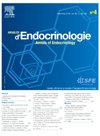抗勒氏激素:多囊卵巢综合征的新诊断指标?
IF 2.9
3区 医学
Q3 ENDOCRINOLOGY & METABOLISM
引用次数: 0
摘要
多囊卵巢综合征(PCOS)是一种影响5-15%育龄妇女的内分泌紊乱。基于鹿特丹标准的诊断包括卵巢超声,这取决于操作者,并受到一些限制。由窦卵泡颗粒细胞产生的抗本文章由计算机程序翻译,如有差异,请以英文原文为准。
Anti-müllerian hormone: A new diagnostic marker for polycystic ovary syndrome?
Introduction
Polycystic ovary syndrome (PCOS) is an endocrine disorder affecting 5–15% of women of reproductive age. Diagnosis based on the Rotterdam criteria includes ovarian ultrasound, which is operator-dependent and subject to several limitations. Anti-Müllerian hormone (AMH), produced by granulosa cells of antral follicles, is emerging as an alternative biomarker. This study aims to determine an optimal AMH diagnostic threshold for Tunisian women.
Materials and methods
This multicenter, cross-sectional case-control study included 31 PCOS patients diagnosed according to the Rotterdam criteria and 31 age- and BMI-matched controls. Serum AMH levels were measured using an electrochemiluminescence assay. Pelvic ultrasound was performed transabdominally and, when feasible, transvaginally or transrectally. Correlations between AMH, age, testosterone levels, and antral follicle count were assessed using linear regression analysis.
Results and discussion
The mean AMH level was 3.6 times higher in PCOS patients (7.69 ng/mL) than in controls (2.12 ng/mL; P <10−3). A significant positive correlation was observed between AMH and antral follicle count (B = 0.25; P <10−3) as well as with testosterone levels (B = 0.07; P <10−3). A negative correlation with age (B = −0.15; P <10−3) was also demonstrated. ROC curve analysis identified an optimal diagnostic threshold of 3.41 ng/mL, with a sensitivity of 97% and a specificity of 90%.
Conclusion and limitations
AMH is a reliable biomarker for PCOS in hyperandrogenic Tunisian women, potentially replacing ovarian ultrasound when it is unavailable, inconclusive, or lacks an experienced operator. Study limitations include the absence of phenotype D in our cohort and the need for validation in larger populations.
求助全文
通过发布文献求助,成功后即可免费获取论文全文。
去求助
来源期刊

Annales d'endocrinologie
医学-内分泌学与代谢
CiteScore
4.40
自引率
6.50%
发文量
311
审稿时长
50 days
期刊介绍:
The Annales d''Endocrinologie, mouthpiece of the French Society of Endocrinology (SFE), publishes reviews, articles and case reports coming from clinical, therapeutic and fundamental research in endocrinology and metabolic diseases. Every year, it carries a position paper by a work-group of French-language endocrinologists, on an endocrine pathology chosen by the Society''s Scientific Committee. The journal is also the organ of the Society''s annual Congress, publishing a summary of the symposia, presentations and posters. "Les Must de l''Endocrinologie" is a special booklet brought out for the Congress, with summary articles that are always very well received. And finally, we publish the high-level instructional courses delivered during the Henri-Pierre Klotz International Endocrinology Days. The Annales is a window on the world, keeping alert clinicians up to date on what is going on in diagnosis and treatment in all the areas of our specialty.
 求助内容:
求助内容: 应助结果提醒方式:
应助结果提醒方式:


